If you’re planning a visit to Olympic National Park and want to explore the coast, you might be wondering: Where are the best tide pools in Olympic National Park?
It can be tricky to know which beaches actually have great tide pooling, when to go so the tides work in your favor, and what to look for once you get there.
That’s exactly what this guide is here to help you with.
I’ve explored all up and down the coastline here and I’ll share what I loved – like spotting purple sea stars clinging to sea stacks – and what I’d skip next time, so you can make the most of your trip.
This is for first-time visitors, families with curious kids, photographers looking for marine life shots, and anyone who wants to experience the best tide pools in Washington without wasting time on less impressive spots.
Here’s a quick teaser: one of my favorite spots will let you see bright green anemones, starfish in shades of orange and purple, and tiny crabs scuttling through clear pools – all framed by dramatic coastal scenery.
In this complete guide to the best tide pools Olympic National Park has, I’ll cover exactly where to find them, the best times to visit, how to stay safe, and insider tips that will make your tide pooling adventure unforgettable.
Let’s get started.
🛏️TOP HOTEL PICK: Check availability now
🚘FIND THE CHEAPEST CAR RENTAL: Search Discover Cars for the best deals
✈️FIND THE CHEAPEST FLIGHTS: Search Skyscanner for the best deals
🧳GET TRAVEL INSURANCE: Get insured with Travelex before you go
📱TAKE AN AUDIO TOUR: Buy an audio tour now
Table of Contents
The Best Tide Pools Olympic National Park
Subscribe to daily national parks planning tips, travel inspiration and trip ideas and get instant access to the free PDF of the
Best Tide Pools Olympic National Park: Complete Guide
5. Kalaloch Beach 4 Tide Pools
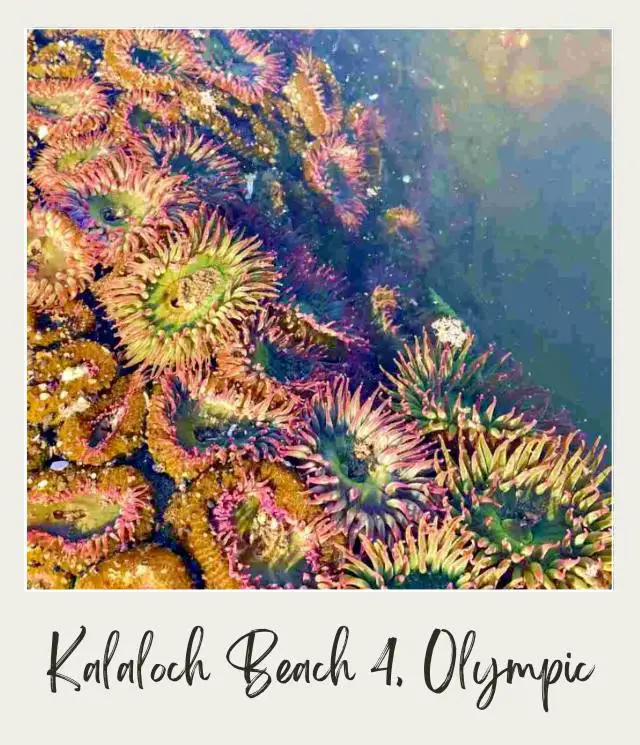
Beach 4 has, in my opinion, the best tide pooling of all the Olympic National Park beaches. The beach is not the most dramatic, the tide pools are teeming with colorful marine life and you can easily spend several hours exploring the tide pools there.
Distance to beach
0.2 miles each way
Beach Access
Easy – moderate. The trail itself is short, but has some elevation change.
However, if you have mobility issues, getting to the beach is a challenge. The trail pops you out at a short wooden bridge that spans from the hillside to some rocks on the edge of the beach. Then you need to get down the rocks to the beach. There is a rope that you hold on to as you back down the steep rocks. It’s only a short distance, but nonetheless can be daunting if you have any mobility issues.
Where to Find the Best Tide Pools on Beach 4
When you enter the beach, head north (right) and look for a large rock at the water’s edge. The best tide pools are at the north side of this large rock.
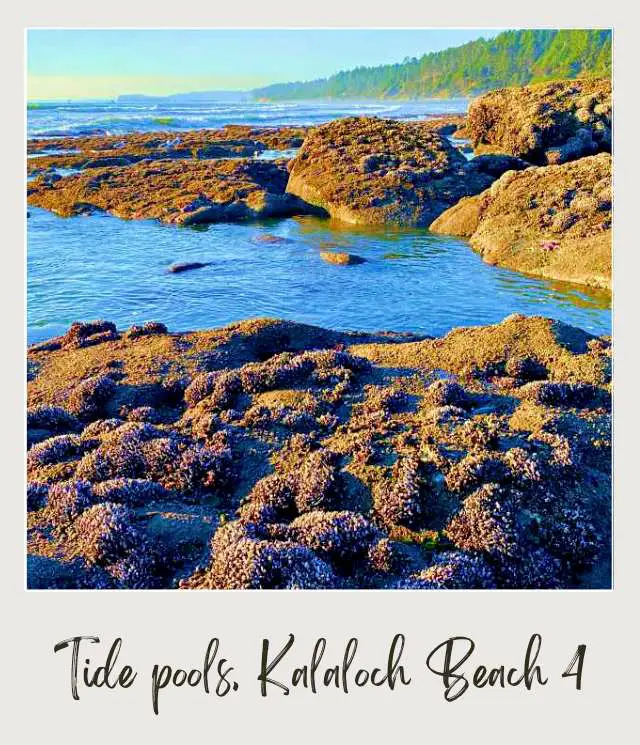
Fee
There is no special trail or beach fee and you don’t pass through any Olympic National Park entrance station to enter Beach 4 so you can visit the beach for free.
However, if you are going to enter other sections of Olympic National Park like Sol Duc, Hoh Rain Forest and Hurricane Hill, you will need to pay the Olympic National Park entrance fee. Paying the fee helps support our parks.
Buy it online or, if you are planning to visit more than just Olympic National Park this year (Mount Rainier National Park and North Cascades National Park are both close), it can be great value to purchase an America The Beautiful pass.
When is Beach 4 Open?
Beach 4 is open year-round.
Kalaloch Tide Table
I recommend checking the official NOAA Kalaloch tide chart here when you are planning your trip so you can visit at the right time. This tide chart is considered the most reliable and is the one recommended by the NPS.
Pros of Beach 4 Tide Pools
- The best tide pools in Olympic National Park. So many creatures to see.
- A short walk from the beach access
- The hike to the beach is not too long
Cons of Beach 4 Tide Pools
- You need to use a rope to assist you descending some rocks to get on to the beach. This is not possible or very difficult if you have mobility issues.
➡️ READ MORE: Kalaloch Beach 4 Guide
4. Rialto Beach Tide Pools
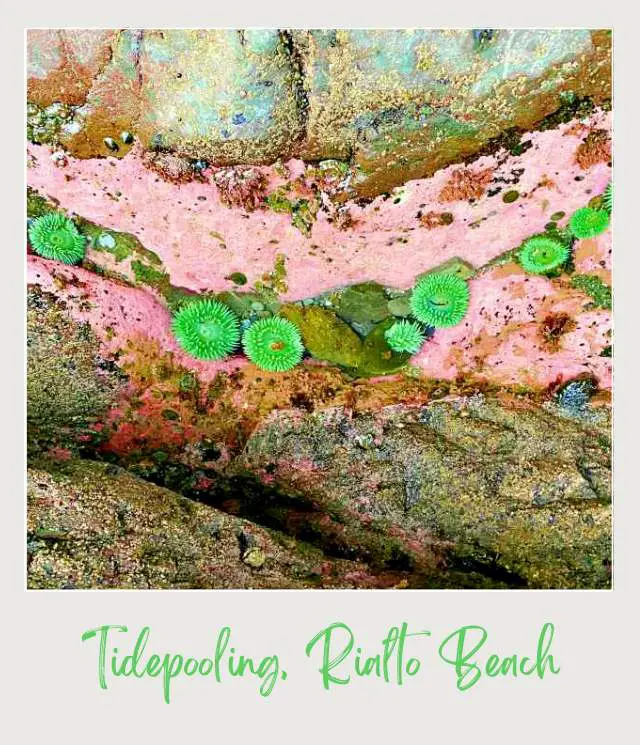
Rialto Beach is the most accessible beach on the Olympic Peninsula, although you need to walk along the beach to get to the tide pools.
There are several sea stacks on the shore, but main attraction on Rialto Beach is Hole in the Wall – a dramatic natural arch carved by the wind and sea through a rocky outcrop. The tidepools are spread around the base of the arch, so it’s easy to combine visiting the arch with exploring the tide pools.
Distance to beach
The beach is a about 100 feet from the parking area, but it’s 3.3 miles round trip to the tide pools.
Beach Access
Easy – moderate. The beach is close, but the tide pools are near the Hole in the Wall natural arch. This is about 1.7 miles down the beach to the right. It’s flat, but walking in soft sand can be tiring.
Where to Find the Best Tide Pools on Rialto Beach
When you enter the beach, head north (right) and walk for about 1.7 miles. The best tide pools are all around the Hole in the Wall natural arch.
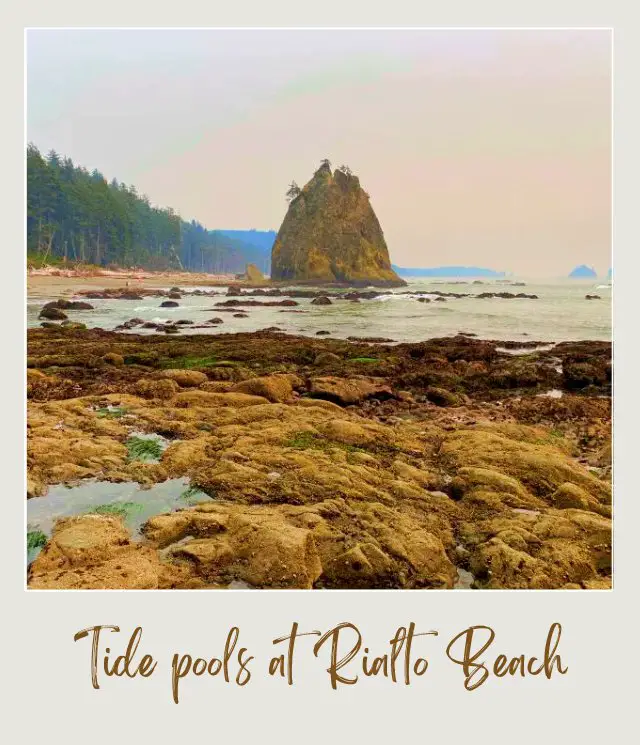
Fee
There is no special trail fee and you don’t pass through any entrance station to enter Rialto Beach, so you can visit the beach for free.
However, if you are going to enter other sections of Olympic National Park like Sol Duc, Hoh Rain Forest and Hurricane Hill, you will need to pay the Olympic National Park entrance fee. Buy it online or, if you are planning to visit more than just Olympic National Park this year (Mount Rainier National Park and North Cascades National Park are both close), it can be great value to purchase an America The Beautiful pass.
When is Rialto Beach open?
Rialto Beach is open year-round.
Rialto Beach Tides Chart
To reach the tide pools, you’ll need to visit at low tide. To ensure that you have enough time to explore the tide pools, plan to arrive at Hole in the Wall at least 30 minutes before the lowest tide.
I recommend checking the official tide chart here when you are planning your trip so you can visit at the right time.
Pros of Rialto Beach Tide Pools
- The tide pools are around the base of the Hole in the Wall, a dramatic and beautiful natural arch.
- The beach is the most accessible with just a short, flat walk from the parking lot.
Cons of Rialto Beach Tide Pools
- It’s a 1.7-mile walk (about one hour) each way from the beach entrance to the tide pools.
- There’s less variety and quantity of marine life than at Beach 4.
➡️ READ MORE: Rialto Beach Guide
3. Ruby Beach Tide Pools
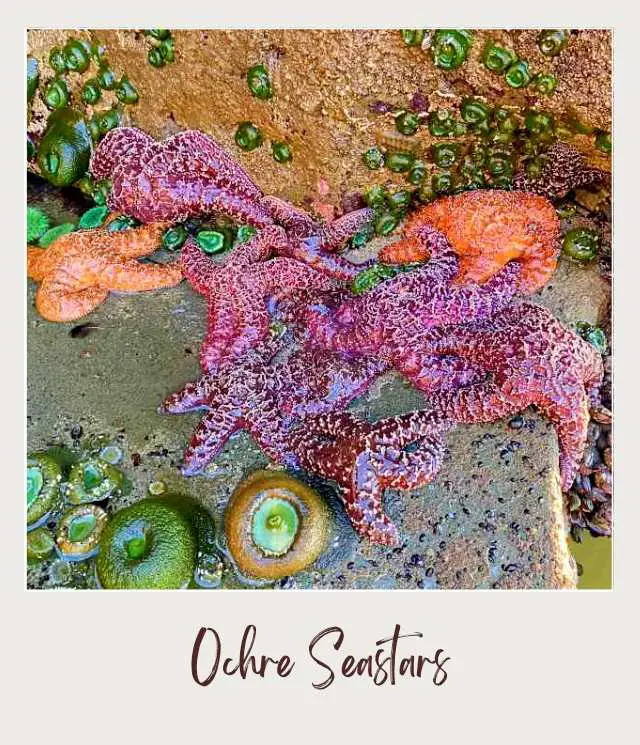
Ruby Beach is named after the ruby-like crystals in the beach sand. These reddish minerals are ‘almandite’, a type of garnet.
The beach has more to offer than red crystals, however. It’s incredibly beautiful, with the sea stacks and enormous driftwood that characterize Olympic Peninsula beaches.
Tide pools form around the edges of the sea stacks between the rocks and the sand, as well as among rocks along the beach. This makes it great for tide pooling with young kids especially, as they don’t need to walk out on slippery rocks to explore the pools.
Distance to beach
0.25 miles each way
Beach Access
Easy-Moderate. The trail is short with minimal elevation change.
However, when you arrive at the beach, there is also a pile of driftwood that you need to navigate. Always walk very carefully on driftwood, as it can shift as you are walking on it.
Where to Find the Best Tide Pools on Ruby Beach
The tide pools are around the bases of the sea stacks. Unlike the other beaches on this list, many of the tide pools are formed by the rock wall of the sea stacks on one side and then shallow troughs around the bases, with the other ‘walls’ being the sand.
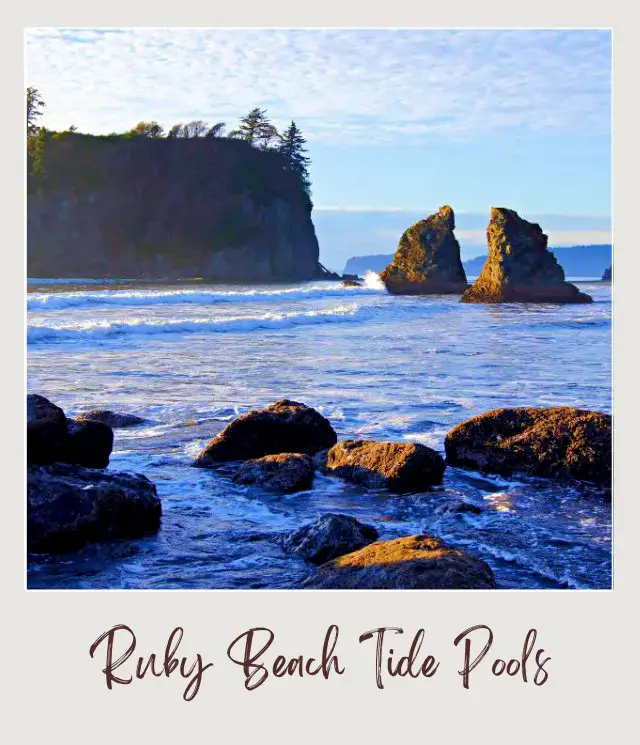
Fee
There is no special trail or beach fee and you don’t pass through any Olympic National Park entrance station to enter Ruby Beach so you can visit the beach for free.
However, if you are going to enter other sections of Olympic National Park like Sol Duc, Hoh Rain Forest and Hurricane Hill, you will need to pay the Olympic National Park entrance fee. Paying the fee helps support our parks.
Buy it online or, if you are planning to visit more than just Olympic National Park this year (Mount Rainier National Park and North Cascades National Park are both close), it can be great value to purchase an America The Beautiful pass.
When is Ruby Beach open?
Ruby Beach is open year-round.
Ruby Beach Tide Chart
Check the official Kalaloch beach tide chart here when you are planning your trip so you can visit at the right time. Plan to arrive at the beach at least 30 minutes before the lowest tide.
Pros of Ruby Beach Tide Pools
- Short trail to the beach
- Tide pools form around the edges of sea stacks, so you can approach them directly from the sand without needing to walk on slippery rocks
Cons of Ruby Beach Tide Pools
- Need to clamber over driftwood to get to beach
- Not as much variety of marine life as Beach 4
➡️ READ MORE: Ruby Beach Guide
2. Second Beach Tide Pools
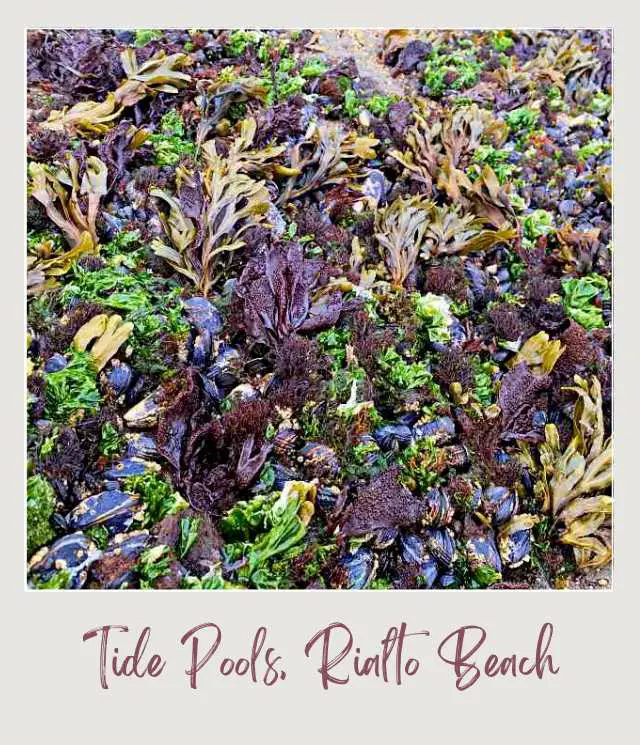
Second Beach will literally take your breath away. The usual oversized, sun-bleached driftwood piles and mystical sea stacks off shore create a breathtaking view. The beach itself is sandy and easy to walk on.
There are rock pools covered in kelp and sea grasses in the middle of the beach and more tide pools at the headlands at each end of the beach.
Distance to beach
0.7 miles each way
Beach Access
Easy – moderate. Most of the trail is a gradual decline, but as the trail nears the beach, it descends quite steeply down a series of stepped switchbacks. When you reach the beach, there is sometimes a pile of driftwood to climb over, but sometimes you can walk directly from the trail n to the sandy beach.
Where to Find the Best Tide Pools on Second Beach
If you head left, there are rock pools around Teahwhit Head on the southern end of the beach. Some of the best tide pools, though, are around the base of the sea stacks.

Fee
There is no special trail or beach fee and you don’t pass through any Olympic National Park entrance station to enter Third Beach so you can visit the beach for free.
However, if you are going to enter other sections of Olympic National Park like Sol Duc, Hoh Rain Forest and Hurricane Hill, you will need to pay the Olympic National Park entrance fee. Paying the fee helps support our parks.
Buy it online or, if you are planning to visit more than just Olympic National Park this year (Mount Rainier National Park and North Cascades National Park are both close), it can be great value to purchase an America The Beautiful pass.
When is Second Beach open?
Second Beach is open year-round.
Second Beach Tide Chart
I recommend checking the official tide chart here when you are planning your trip so you can visit at the right time. Plan to arrive at the beach at least 30 minutes before the lowest tide.
Pros of Second Beach Tide Pools
- Very beautiful beach.
- Large parking area.
Cons of Second Beach Tide Pools
- Not as much marine life as some of the other beaches.
- Steep descent to beach.
➡️ READ MORE: Second Beach Guide
1. Third Beach Tide Pools
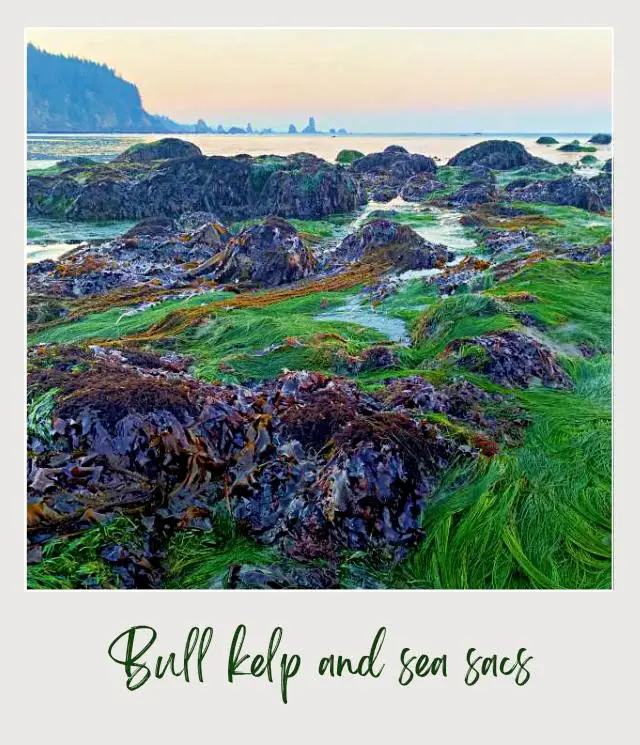
Third Beach is the least visited of these beaches, mostly because it is a longer hike to get there.
It’s worth the effort to get there, though. The beach is beautiful and there are rock pools with giant kelp as well as tide pools with sea creatures to discover.
Distance to beach
1.4 miles each way.
Beach Access
Moderate. The trail is the longest access trails to the five beaches listed here. It’s mostly flat, but does have some elevation change, and there are tree roots to look out for.
When you arrive at the beach, you need to walk along the top of several enormous driftwood logs to get to the beach.
Where to Find the Best Tide Pools on Third Beach
There are some rocks in front of you as you get on the beach. These are often covered in giant kelp and sea grasses. There are more tide pools at the headlands at each end of the beach.
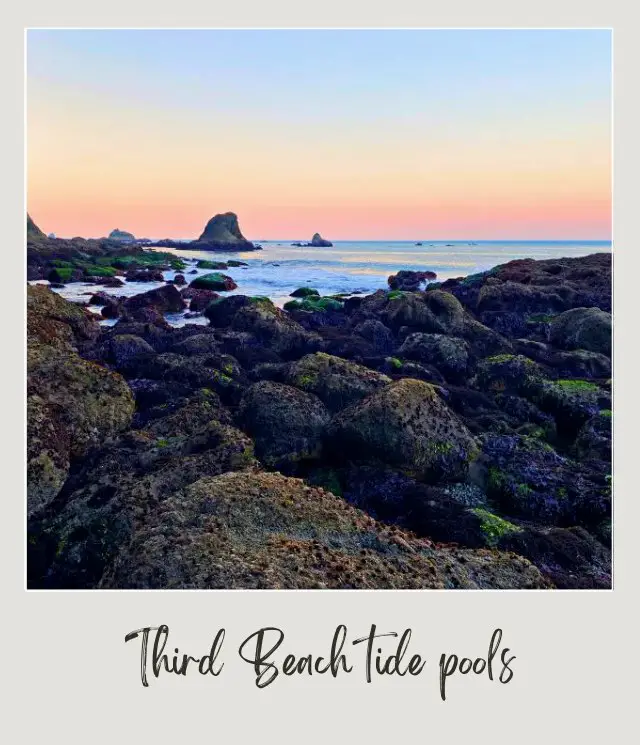
Fee
There is no special trail or beach fee and you don’t pass through any Olympic National Park entrance station to enter Third Beach so you can visit the beach for free.
However, if you are going to enter other sections of Olympic National Park like Sol Duc, Hoh Rain Forest and Hurricane Hill, you will need to pay the Olympic National Park entrance fee. Paying the fee helps support our parks.
Buy it online or, if you are planning to visit more than just Olympic National Park this year (Mount Rainier National Park and North Cascades National Park are both close), it can be great value to purchase an America The Beautiful pass.
When is Third Beach open?
Third Beach is open year-round.
La Push Beaches Tides Chart
As with the other beaches, you’ll need to visit at low tide. Plan to arrive at Third Beach at least 30 minutes before the lowest tide.
Check the official tide chart here when you are planning your trip so you can visit at the right time.
Pros of Third Beach Tide Pools
- Fewer people than the other beaches.
- Beautiful beach with a coastal waterfall.
Cons of Third Beach Tide Pools
- Limited parking at the trailhead.
- Longer hike to the beach.
- Not as much marine life as some of the other tide pools.
➡️ READ MORE: Third Beach Guide
There are so many amazing tidepools in Olympic National Park. And chances are you want to see them all! But you may be wondering “How do I include them all into my trip?” I hear this all the time.
Getting an idea of all the best tidepools in the park is a start – and an important start. But the really tricky part is coordinating seeing them all into an itinerary that actually makes sense – so that you’re seeing the waterfalls at the right time of day, adding in other activities and joining them all together in a logical order, and managing all the logistics that makes them happen.
To help take away the overwhelm of planning a trip to Olympic I’ve created several super detailed itineraries.
There are 1-, 2-, 3-, and 4- day options for Olympic National Park: all with detailed hour-by-hour schedules, including alternatives for different activity and fitness levels, plus trail maps and descriptions, driving instructions, important information, essential tips, and everything else you need to make the most of your time in Olympic National Park.
Obviously, the more days you spend in Olympic National Park, the more tidepools you can explore. You’ll see four of them on the 3 and 4-day itineraries. If you want to see them all, stay an extra day. And if you have less time, the itineraries will help you make the most of whatever time you have available.
Map of Olympic National Park Tide Pools
Here are the locations of the beaches with the best tide pooling in Olympic National Park.
What You Need To Take/ Wear Tide pooling in Olympic National Park
1. I recommend taking a rain jacket and wearing layers that you can take off or put on depending on the weather, which can change throughout the day. If you need one, I like this Columbia rain jacket for men and this Little Donkey Andy rain jacket for women.
2. You’ll definitely want to take a camera. I love the GoPro HERO 12. It is designed for travel. It’s water resistant and durable, which is especially important when you might slip and the camera could end up wet. Check current prices on the GoPro HERO 12 here
3. Check my list of essential things to take and wear on a day hike to make sure you have everything you need.
4. Water shoes or sturdy hiking shoes or boots or sandals with a good sole. You’ll spend most of the time walking on sloping, wet rocks. They can be slippery. They are also sharp, as you may end up walking over shells that have very sharp edges. So, you’ll want to wear good hiking boots, shoes or sandals.
➡️ If you need to get some boots, take a look at my Guide to Buying the Best Hiking Shoes/ Boots to help you know what to look for and get some recommendations. My top pick is this pair of Salomon Gore-Tex boots. An alternative to hiking shoes or boots are hiking sandals. These have the advantage of being fine in water as well as having good grip.
➡️ If you’re interested in buying some, check out my Complete Guide To The Best Hiking Sandals or get my favorite pair: KEEN Unisex-Adult Targhee 3 Open Toe Hiking Sport Sandal
5. Take water. I love this hydroflask. It’s easy to carry, keeps temperatures well, and comes in multiple colors.
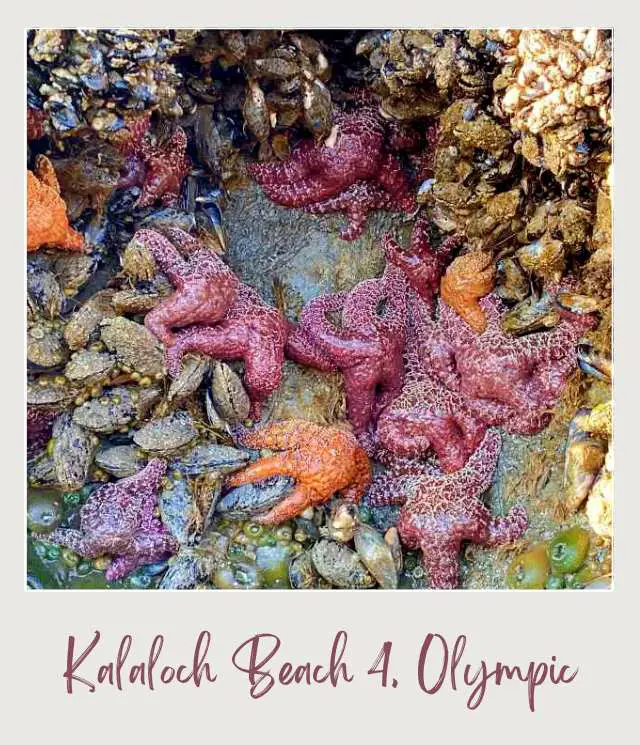
Tips for Exploring the Olympic National Park Tide Pools
Here are my top tips for exploring the tide pools that will make your experience safer and more enjoyable.
1. Time the hike for low tide
You can see tidepools during positive tide times (up to 1.5), but the best low tide times are below 0 tide. Plan to arrive at the beach at least 30 minutes before the lowest tide so you have sufficient time to spend there before your return hike.
2. Check the tide chart
I recommend checking the official NOAA tide chart here when you are planning your trip so you can visit at the right time. This tide chart is considered the most reliable and is the one recommended by the NPS.
When you look at the tide chart, you may notice that some low tides are ‘negative tides’ meaning that they go below sea level. This is when tide pools are best, though any low tide is usually fine.
3. Wear the right footwear
When exploring the tidepools, you’ll need to clamber over wet rocks that can be steep and slippery and have sharp shells. To reach most of these beaches, you need to hike through coastal forest and then clamber over large driftwood piles.
So, it’s essential that you have comfortable hiking shoes or boots that you can then get wet and have really good tread. I really like this pair of Salomon Gore-Tex boots.
Or alternatively, you can wear hiking shoes to the beach and then swap into water shoes that have good tread.
➡️ If you’re interested in buying some hiking sandals, check out my Complete Guide To The Best Hiking Sandals or get my favorite pair: KEEN Unisex-Adult Targhee 3 Open Toe Hiking Sport Sandal
4. Note the trail back when you arrive
When you get on to the beach, take a look back so you can easily identify where you entered (and therefore where you to exit) the beach.
Some beaches are easier than others to identify because of the unusual formations, but if not, there is usually a circular sign with alternating red and black quarters on a nearby tree to indicate where you’ll find the trail back from the beach to the parking lot.
5. Be prepared for cold (and changeable) weather
While it can be warm and sunny in summer, this is by no means guaranteed. The Pacific Northwest is much more famous for fog and rain than it is for sun.
Even when the sun is shining inland, the beach is often shrouded in fog and it can rain at any time. I recommend taking a rain coat with you.
➡️ If you need a raincoat, I like this Columbia rain jacket for men and this Little Donkey Andy rain jacket for women.
6. Watch the tides and waves
Keep a careful out for the returning tide and look at the time (know in advance the tide times) so you can make sure you safely make it back before the tide rises. Also keep an eye out for “sneaker waves.”
7. Test rocks before stepping on them
Many of the rocks will be covered in algae and seaweed, which makes them extremely slippery. Never leap from rock to rock. Always step carefully and test rocks with one foot while keeping your weight on a secure foot before committing to stepping on new surfaces.
8. Keep children close
Rocks and waves can be unpredictable, and rocks are slippery, so always keep a very careful eye on children and don’t venture far on to the rocks if they seem unsafe.
9. Leave your dog(s) at home
Dogs are actually not permitted on these beaches (near the rock pools) and there are several good reasons. One reason is that tide pools can have sharp rocks, mussels and barnacles that can slice into dog’s paws and cause infection.
10. Peer under rocks
When you see rock overhangs in the water, look under the rocks. There are often creatures like hanging sea anemones hiding under the overhang.
11. Only step on bare rocks
Avoid stepping on barnacles and mollusks – they are living creatures. And, as always, Leave No Trace. As with every trail, beach, etc. that you visit, always leave the tide pools and beach exactly as you found them. 😊
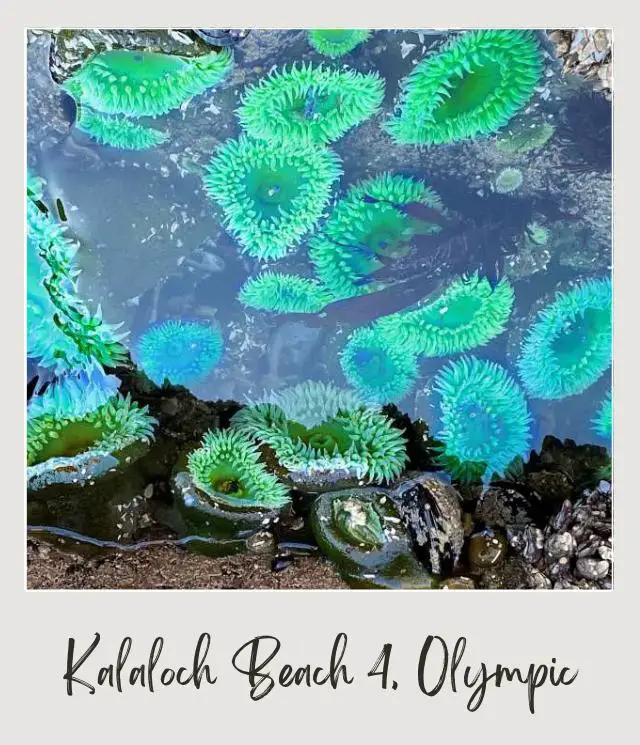
Weather
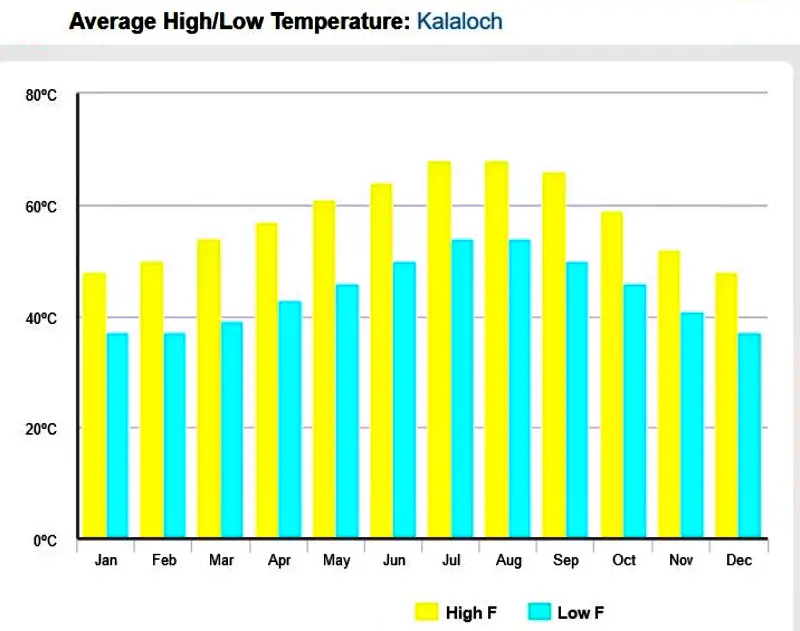
Summer is by far the most popular time to visit the Olympic Peninsula and this is also when the weather is by far the best. There is a lot – in WP already less rain in summer, though rain and thunderstorms are possible at any time and it can be foggy on the coast even on sunny days. Temperatures are mild. August is the warmest month of the year, but even then, average temperatures are between 53.1°F and 64.8°F.
Winter is by far the wettest season. This is when the region gets the bulk of the rain – and it is a LOT of rain. Temperatures are surprisingly mild, though. The coldest month is December, with an average low-temperature of 40.6°F and an average high-temperature of 45.5°F.
Spring and Fall are similar but opposite. In spring, the temperature is rising and the rainfall is decreasing, while in fall, temperatures are falling and rainfall is increasing.
September is a lovely month with still very mild temperatures and not too much rain, but the other months are a mixed bag, with unpredictable weather.

FAQS about Olympic National Park Tide Pools
What is a Tidepool?
A tide pool is “a shallow pool of water that forms on the intertidal shore.” This means that at high tide, they are completely under water, but as the tide goes out, water gets traps between rocks, in basins, alcoves, and crevices, forming pools of sea water.
Certain plants and animals live in these pools all the time, and some get washed in with the tide and washed out with the next tide.
How are tide pools formed?
Not all coastlines have tide pools. They are formed when there are rocks with spaces in the intertidal zone so that water gets trapped there between low and high tides.
What is Tidepooling?
Tidepooling is a popular activity in areas where tide pools form.
Tidepooling is exploring the tide pools and looking at all the animal and plant life that loves there. It’s fascinating and fun to see the daily lives of the fish, invertebrates and plants that live in the tide pools. It’s not often that we get a chance to see marine life outside an aquarium unless we snorkel or scuba dive, but tidepooling is an activity anyone with reasonable mobility can enjoy.
What animals are in tide pools?
Tidepools are pretty amazing if you think about it. Half the time they are completely underwater. The rest of the time they are shallow water exposed to the elements and often pounded by surging waves. It takes a special kind of creature to survive and thrive there.
Surprisingly, perhaps, there are plenty of animals in the tide pools in the Pacific Northwest.
Many of the animals that make tidepools their home are invertebrates (animals without a spine). Some of the most common creatures you’ll see are the Giant Green Anemones (Anthopleura xanthogrammica). They are kind of slimy and brown when they’re out of water but when they’re in water, they have beautiful green fronds. You can also see Aggregating Anemones (Anthopleura elegantissima), which are green and pink.
The other prominent creatures you’ll see are Ochre Seastars (Pisaster ochraceus). These are large orange, purple, and brick red sea stars that cling to the rocks and are often clustered together. They use suction caps to attach themselves to rocks so they don’t get tossed around by the waves, but they can move if they want to.
You’ll also see mollusks and barnacles attached permanently to the rocks.
If you look closely, you may see Cooper’s Chiton (Lepidozona cooperi), also known as a Coat-of-Mail shell, buried within the sands and under rocks of the shallow pools. You can identify them by their distinct row of scales.
You’ll also often see hermit crabs and even purple-shelled Dungeness Crab (Cancer magister) in the rock pools and amongst sea grasses.
These are all pretty permanent residents of the tide pools, but there are also temporary residents who wash in with the tides. If you’re lucky, you may see an octopus or small fish that got trapped in the pools with this particular tide.
If you’re there are a particularly low ride, you may see creatures from the Low Tide Zone like spiky Sea Urchins and brightly colored Nudibranch.
There are also plants that live in the tide pools in the Pacific Northwest. These include bright green sea grasses and golden giant kelp with large sacs that they use to float their fronds to the surface at high tide.
What are some fun tide pool activities?
1. Of course, the most popular activity with tide pools is to just spend time looking into the tide pools and seeing what you find. Share your discoveries with the people around you.
2. Another fun activity if you are tide pooling with kids is to have a scavenger hunt. Use the animals and plants listed above to create a list that kids need to find and check off.
3. There are also great books for kids about tide pools that they can read beforehand and then explore the tidal pools to see what is similar and different from the books. Check out a fun tide pools book for kids here.
What are some fun facts about tide pools?
Did you know?
1. Many of the animals in tide pools are low and rounded to withstand pounding surf.
2. Some animals, like barnacles, attach themselves to rocks permanently by secreting a cement. Others, like seastars, have suction pads that they use to attach themselves (temporarily) to the rocks.
3. Sea anemones cluster together because this helps reduce evaporation; crowds out competing organisms; and amasses more tentacles to catch, sting and hold prey.
What time of year is best for tide pools?
According to NOOA, early summer mornings and late fall and winter afternoons generally have the year’s lowest tides, so these are the best times for tide pools.
Where is the best place to see tidepools in Washington state?
The best tide pools in Washington are at Kalaloch Beach 4.
The tide pools on Rialto Beach around Hole in the Wall are also great and many people choose these as their top pick.
Can you swim in tidal pools?
Technically you can. However, most of the tidepools here are in among rocks and there are animals living in them. Plus the water is freeing cold. So I wouldn’t.
An exception is some of the tide pools at Ruby Beach. A large shallow pool forms in the beach and this is sandy and much warmer than the ocean, so it’s a good place for young kids to take a dip.
Can you touch animals in tide pools?
No, you can look, but should never touch any of the animals that live in the tide pools.
What do you wear to tidepooling?
You’ll spend most of the time walking on sloping, wet rocks. They can be slippery. They are also sharp, as you may end up walking over shells that have very sharp edges. So, you’ll want to wear good hiking boots, shoes or sandals.
➡️ If you need to get some boots, take a look at my Guide to Buying the Best Hiking Shoes/ Boots to help you know what to look for and get some recommendations. My top pick is this pair of Salomon Gore-Tex boots.
An alternative to hiking shoes or boots are hiking sandals. These have the advantage of being fine in water as well as having good grip.
➡️ If you’re interested in buying some, check out my Complete Guide To The Best Hiking Sandals or get my favorite pair: KEEN Unisex-Adult Targhee 3 Open Toe Hiking Sport Sandal
If you’re planning to visit Olympic National Park by yourself, make your planning easy and stress free with a detailed itinerary. I have 1-, 2-, 3- and 4-day itineraries for Olympic National Park that include all the park highlights, give you choices based on your preferred activity level, and take all the stress out of planning your trip.
Travel Insurance for Olympic National Park
No matter which tide pools you visit, you should definitely get travel insurance. This can protect you against medical and emergency repatriation, and cover things like trip cancellation, loss and/ or theft of property, etc.
➡️ A great insurance option is Travelex. It has coverage for all you’ll need. You can choose the best travel insurance plan for your trip here or get a quote right now:
Enjoy these tide pools: Washington coast
More Planning Resources for Olympic National Park
⭐ Olympic National Park Guide
⭐ Olympic National Park Itinerary
⭐ 7 Mistakes to Avoid in Olympic
⭐ How Many Days in Olympic National Park?
⭐ Packing List for Olympic National Park
⭐ Best Things to Do in Olympic National Park
⭐ Best Views In Olympic National Park
⭐ Best Waterfalls in Olympic National Park
⭐ Best Hikes in Olympic National Park
⭐ Visiting Hurricane Ridge: Complete Guide
⭐ Best Hurricane Ridge Hikes
🔹 Hurricane Hill Trail Guide
🔹 Cirque Rim Trail Guide
🔹 High Ridge Trail to Sunrise Point Trail Guide
⭐ Best Hikes Near Lake Crescent
🔹 Marymere Falls Trail Guide
⭐ Best Sol Duc Hikes
🔹 Sol Duc Falls Trail Guide
🔹 Ancient Groves Nature Trail Guide
🔹 Sol Duc Salmon Cascades
⭐ Best Hoh Rainforest Hikes
🔹 Hall of Mosses Trail Guide
🔹 The Hoh River Trail Guide
⭐ Best Olympic National Park Beaches
⭐ 12 Tips for Visiting Olympic National Park
🔹 Rialto Beach Guide
🔹 Kalaloch Beach 4 Guide
🔹 Third Beach Guide
🔹 Second Beach Guide
🔹 The Tree Of Life
⭐ Best Lake Quinault Hikes
🔹 Maple Glade & Kestner Homestead Trails
⭐ Lake Quinault Loop Drive: A Complete Guide
⭐ How To Get to Olympic National Park
⭐ All The Airports Near Olympic National Park
⭐ The Closest Airport to Olympic National Park
⭐ When is The Best Time To Visit Olympic National Park?
⭐ What To Expect Throughout the Year
⭐ 10 Fun Facts About Olympic National Park
What do you think are the best tide pools: Olympic Peninsula? I’d love to hear about them. Join my private Facebook group National Parks Collectors and comment and let me know (you can also pick up extra planning tips, share your photos and stories with other national park lovers and more).
Subscribe to daily national parks planning tips, travel inspiration and trip ideas and get instant access to the free PDF of the
Best Tide Pools Olympic National Park: Complete Guide
If you liked this article, Pin It to your Olympic National Park board!

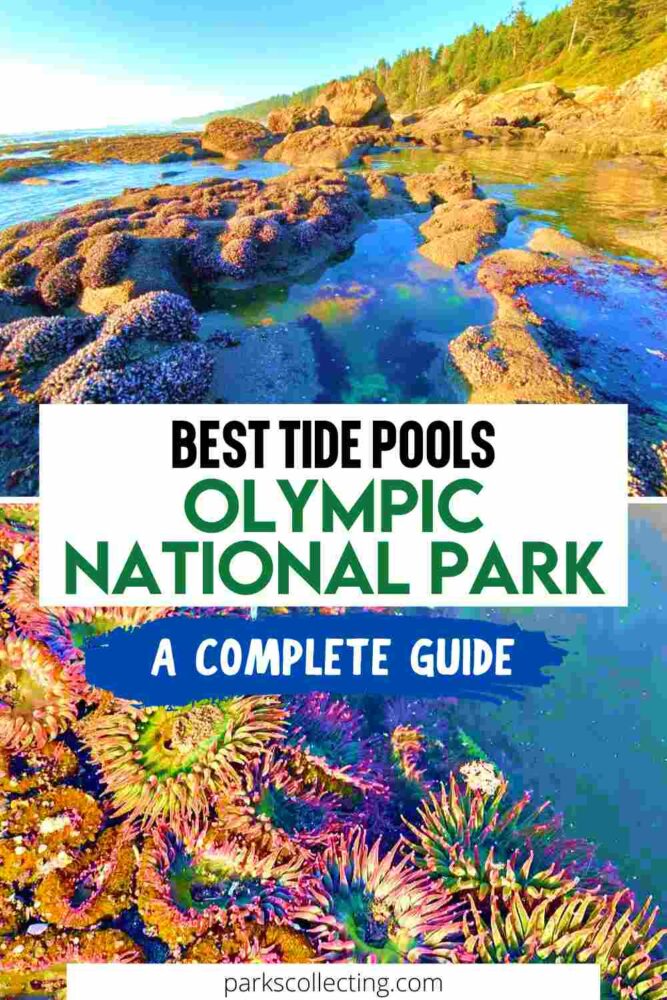
💡 Are you just starting to think about taking a national parks trip? Get Inspiration
‼️ Are you looking for helpful tips for visiting US national parks? Read articles that share useful tips on a range of national-park related issues
💻 Are you starting to plan a trip to Olympic National Park? Read my Guide to Olympic National Park
📋 Do you want a ready-made super detailed plan for your trip to Olympic? Get a detailed 1 – 4-day Olympic National Park Itinerary
💲 Are you ready to book your trip? Use these Planning and Booking Resources
📖 Do you want to read a book about US national parks? Check out my Recommended Reading Lists
About the Author
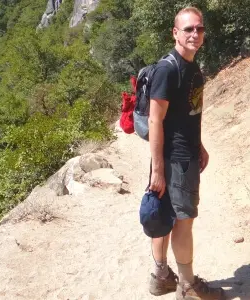
James Ian is a national park, camping and hiking expert.
He has dedicated his life to travel, visiting more than 80 countries, all 7 continents and most of the national parks in the United States. With over 35 years experience in the travel industry, James has worked on cruise ships, at resorts and hotels, and as a travel planner who’s helped hundreds of people plan successful trips to US national parks.
Based on his experience visiting our national parks multiple times, in-depth research and expertise as a travel planner, James has published detailed itineraries for many of the major national parks in the US. These itineraries, as well as in-depth park guides, and other resources will help you have your own incredible trip to US national parks without stress and hassle.
As a national park expert, James has contributed to many publications, including USA Today, Newsweek, Time Business News, Savoteur, Best Trip, and Wired.
I’m a member of the Amazon Services LLC Associates Program. As an Amazon Associate I earn from qualifying purchases.
